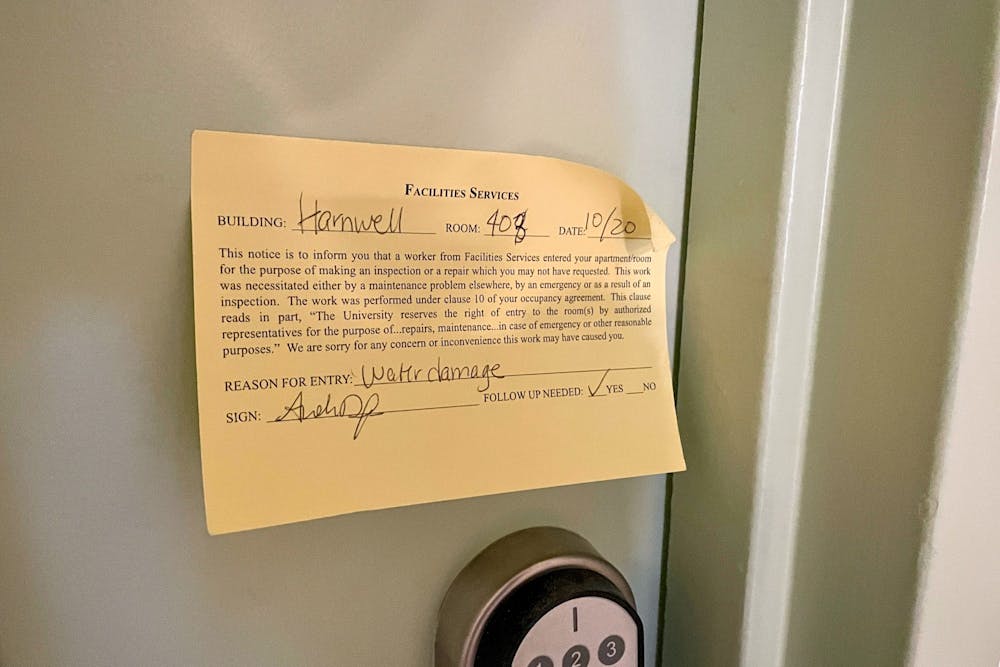
Two flooding evacuations occurred within two weeks, wreaking havoc on residential buildings, destroying personal belongings, and causing student displacement. On Oct. 20, a fire sprinkler erupted in Harnwell College House, resulting in water damage and flooding on floors one through five. The entire building was evacuated at approximately 3:15am, and while most students only lost an hour or two of sleep, 27 students were more significantly affected. Not only did the torrent of “sludgy water” create dorm damages and force 23 students to temporarily relocate, but some also lost valuable personal belongings and essential school materials.
On Oct. 29, thirteen suites flooded in Lauder College House after another fire sprinkler erupted at approximately 3:15pm. Water damage occurred on the seventh floor and below, causing twelve students to be forced to leave their dorms and temporarily relocate to the Sheraton Philadelphia University City Hotel.
Only three days later at approximately 12:30 am, students noticed water gushing from the ceiling of Harnwell’s 24th floor lounge that began overflowing onto couches and tables. While maintenance arrived and quickly contained the issue, many students began packing their belongings in anticipation of another evacuation. Many suites then endured disruptive clanging and water noises coming from their walls for the duration of the night.
However, this is not the first time Penn’s residential dorms experienced flooding. Back in 2016, during peak finals season, a similar sprinkler malfunction occurred, causing “black, dirty water” to gush throughout the seventh floor and below. Students also experienced destruction of their dorms and belongings, in addition to residential displacement.
In the aftermath of those floods, students were forced to endure loud fans and disruptive cleaning crews coming in and out of their rooms. Not only did this disturb their sleep and study schedules, it also put a damper on their mental and physical well-being. Students were unable to experience productivity or peace in their dorms due to these ongoing distractions.
Students’ sleep, class, and exam schedules should not be disrupted because of recurring building malfunctions that they are not responsible for. While all the situations were handled promptly and surely could have been much more severe, every student involved was still negatively affected. To prevent any other potential damages, Penn should make an effort to evaluate all residential buildings and ensure that all operations are running safely and effectively.
Around 5,500 undergraduate and hundreds of graduate students live in Penn’s residential buildings. While many make the decision to live in the dorms, some have no choice due to the two-year undergraduate housing requirement, in addition to financial and accessibility hardships that often prevent off-campus housing. Many students also stay on campus during break periods due to convenience, travel restrictions, summer classes, local jobs, and other personal reasons, therefore causing campus housing to constantly be in use.
Because thousands of students rely on Penn to provide adequate living experiences all year-round, it is crucial that the school conducts comprehensive evaluations of each residential building. Not only do students put their trust in the school to keep them safe and healthy, but they also pour thousands of dollars into housing costs. Furthermore, Penn should understand how vital it is to have comfortable and functioning living spaces for the sake of students’ mental and physical health. Especially at a prestigious university that places such high emphasis on education, Penn must make every effort to prioritize student well-being in order to ensure academic success.
Given the rapid recovery following the two recent floods, it is evident that Penn has the necessary resources to maintain their residential halls and fix any malfunctions. Many damages result from cold weather, and especially with winter right around the corner, it is more important than ever to check on each building. Especially because two major incidents occurred within less than two weeks of another, it is evident that building mechanics are not functioning properly.
This is not to say that full renovations need to occur in the middle of the academic year as that would certainly be unrealistic and unfeasible. However, simple check-ups on all building operations would suffice to ensure that students are not subjected to yet another flood or emergency evacuation.

EMILY CHANG is a College sophomore studying sociology from Holmdel, N.J. Her email address is changem@sas.upenn.edu.
The Daily Pennsylvanian is an independent, student-run newspaper. Please consider making a donation to support the coverage that shapes the University. Your generosity ensures a future of strong journalism at Penn.
Donate







